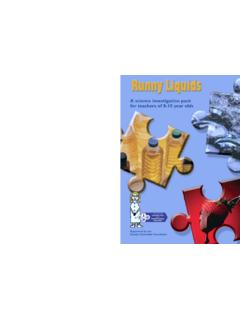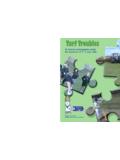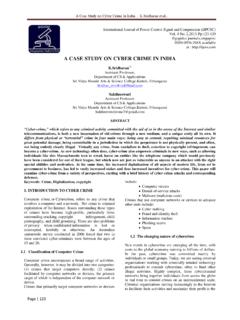Transcription of A science investigation pack for teachers of 8-11 …
1 A science investigation pack for teachers of 8-11 year oldsSupported by the Gatsby Charitable FoundationFor more information on the programmes and publications available from the CIEC, visit our website contact:Chemical Industry Education CentreUniversity of YorkYorkYO10 5DD UKTelephone: 01904 432523e-mail: Feel the Force A science investigation pack for teachers of 8-11 year olds This package was developed by the Chemical Industry Education Centre at the Department of Chemistry University of York Heslington York YO10 5DD Telephone: 01904 432523 Facsimile: 01904 434460 E-mail: Website: Chemical Industry Education Centre First published 2003 ISBN 1 85342 584 2 The contents of this book have limited copyright clearance.
2 They may be photocopied or duplicated for use in connection with teaching within the establishment for which they were purchased. They may not be duplicated for lending, hire or sale. Acknowledgements Many people were involved in developing the activities in this resource, and we would like to offer my thanks to them, and in particular: Anne-Marie Allen, St. Joseph's Primary School, Boston Spa Jonathan Barton, Advisory teacher , Children Challenging Industry, Chemical Industry Education Centre Edith Fielding, St-Michael-in-the-Hamlet Junior School, Liverpool Valmai Firth, Chemical Industry Education Centre Michelle Goundry, Heighington Primary School, Newton Aycliffe Katy Harris, Carlinghow Princess Royal Primary School, Batley Heidi Henrickson, Chemical Industry Education Centre Julie Jones, Advisory teacher , Children Challenging Industry.
3 Chemical Industry Education Centre Fiona Law, St. Mary's Primary School, Malton Mandy Martin-Smith, Cheyne Middle School, Sheerness Eve Morris, Barkston Ash Primary School, Barkston Gayle Pook, Advisory teacher , Children Challenging Industry, Chemical Industry Education Centre Sue Pooley, Heworth Primary School, York Cliff Porter, Educational Consultant, Liverpool Julie Stanley, Eli Lilly and Co. Ltd., Liverpool Bryan Jackson Joy Parvin Project Officer Editor Photograph acknowledgements We thank the following companies, organisations and individuals for giving us permission to use photographs.
4 The numbers refer to the pages on which they can be found. The Mallard is an A4 Pacific class steam locomotive built in 1938 by the LNER and designed by Sir Nigel Gresley in England. It was designed as an express locomotive with a wind-tunnel tested, aerodynamic body which allowed it to reach speeds of over 100 mph. It was in service until 1963 when it was retired after a lifetime distance of almost million miles. It was restored to working order in 1988 to celebrate its 50th anniversary. The Mallard is now part of the collection of the National Railway Museum in York, England.
5 In 1938 it achieved the speed record of its time for a train, with a speed of 126 mph. Courtesy Spectrum Colour Library, , cover, 17, 27 Palmerston was originally built in 1864 by George England & Co. It was finally withdrawn from service in 1940 when it was used by the old Ffestiniog Railway as a stationary boiler. The engine was bought by a group of enthusiasts in the 1970s with a view to restore it to working order. Palmerston eventually returned to steam in 1993. Palmerston is still coal-fired and the engine is treated more as a working museum piece rather than a locomotive for regular use.
6 Courtesy Ffestiniog Railway, Wales, , cover The Pendolino is a 'tilting' locomotive built in 1999 by ALSTOM and developed by Fiat Ferroviaria. It is operated in the UK by Virgin Trains and is designed to reach maximum speeds of 140mph. The Pendolino can negotiate curves 35% faster than conventional trains with no adverse effect on the quality of the ride. In October 2002 a 10% overspeed test saw one of Virgin's Pendolinos reach 138mph between Carlisle and Tebay. Courtesy Priestman Goode, London, England, , cover Early Learning Centre vehicles, 3, Force scale, 8, Vehicle launching, 8, Wind resistance, 9, Bryan Jackson Image of the A3 LNER Flying Scotsman, 17, 27, Jim Pitts, Southern Steam Trains LLC, Travelers Rest, South Carolina, United States JR Central Class 995 '300x' Japanese 'Bullet Train' or 'Shinkansen', 17, 27, Dave Fossett, Saitama, Japan.
7 ~dajf/ Contents Introduction 1 Curriculum links 2 Resource requirements 3 Activity notes 5 Activity sheets 15 Appendices 27 1 Introduction Age range The activities in this book provide an opportunity for children to think about the properties of air and in particular, the frictional forces it exerts.
8 The material is aimed at Year 4 pupils, and can be readily modified for use with Year 5-6 children, particularly by varying the types of measurement carried out. Context The ideas are put into a real-life context, that of a transport company looking for ways to reduce the fuel consumption of it's lorries. See Appendix 1 for more background information. Photographs that can be used with the class can be found on Activity sheet 2, page 17. This approach makes the work more relevant and enjoyable for the children. While an industrial visit is not necessary to complete the work, if a local industry is available to support the work in these activities, it will certainly strengthen the children's understanding and enjoyment of the science work undertaken.
9 Activities The activities take approximately 3 hours, and the activities can be taught in 2 sessions, to suit the timetable, teacher and children. They should be completed in the order given, to follow the sequence of identification of a problem to investigation and finally a solution to the problem. Appendices 2-3 provide lesson plans, as well as a sample assessment grid for one investigation . Activity summary Title Description Page Timing 1 Feel the force The children are introduced to the concept of air resistance as a force by running in playground with sheets of paper.
10 5 35 mins 2 Measuring the force 1 Children compare toy vehicles with different sized front areas to discover that vehicles with a larger front have greater air resistance. 7 50 mins 3 Measuring the force 2 Children investigate the impact of adding various shapes of card to the lorry front (known as fairings) to find out whether there is any impact on the air resistance. 11 60 mins 4 Report back to company Graphs, patterns and data can be reported back to the company with final recommendations. 13 45 mins The Activity sheets should help the children record their findings.









